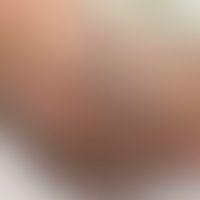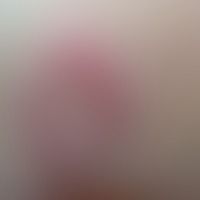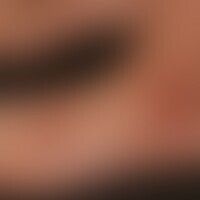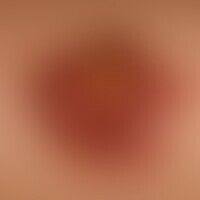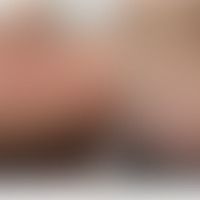Image diagnoses for "Leg/Foot"
395 results with 1158 images
Results forLeg/Foot

Circumscribed scleroderma L94.0
Circumscribed scleroderma. Atrophy of the right leg muscles, atrophy of the gluteal muscles on the right, shortening of the right leg (difference 2.0 cm) with consecutive secondary pelvic obliquity and scoliosis in a 19-year-old female patient. Multiple white indurated plaques on the right leg are also present on the thighs, lower legs and in the foot area.

Arterial leg ulcer L98.4
Ulcus cruris arteriosum: chronic, slowly progressive, painful, deep, sharp-edged ulcer located in the area of the lower leg clitoris, measuring approx. 5.5 x 3.5 cm. The periulcerous area is reddened and overheated. The patient suffers from a PAVK of the multi-level type and has been a heavy cigarette smoker for 30 years.

Contact dermatitis allergic L23.0
Contact dermatitis allergic: chronically recurrent, massively itching, disseminated red papules and papulo vesicles confluent to blurred plaques. maceration of the 4th CCC. The skin lesions were caused by application of a gentamicin-containing cream.
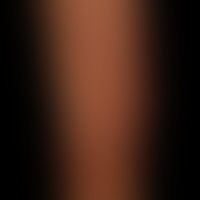
Hypertrophic Lichen planus L43.81
Lichen planus verrucosus: a hypertrophic lichen planus with pseudoepitheliomatous epithelial hypertrophy and scarring that has been present for several years.

Merkel cell carcinoma C44.L
Merkel cell carcinoma: rapidly growing non-symptomatic nodule, in a 73-year-old female patient

Eosinophilic cellulitis L98.3
Cellulitis eosinophil: acute formation of circumscribed, large, sharply margined plaques, the surface of which may have an orange peel-like texture.

Purpura thrombocytopenic M31.1; M69.61(Thrombozytopenie)
Purpura thrombocytopenic: line shaped, fresh skin bleeding (diascopically not pushable away) after intensive scratching

Livedo racemosa (overview) M30.8
Livedo racemosa: irregular, bizarre, not closed circular segments on the lower leg and ankle region, as pioneering morphological indicators of livedo racemosa; for several months, painful, bizarrely configured ulcer in the middle of the calf.

Lateral nevus verrucosus unius lateralis Q82.5
Naevus verrucosus unius lateralis with wart-like papules and plaques.

Hypertrophic Lichen planus L43.81
Lichen planus verrucosus. numerous, chronically stationary, 0.5-5.0 cm in size, rough, brownish or brownish-red, disseminated or confluent, rough, wart-like plaques as well as severe itching in a 63-year-old woman. onset of symptoms about 6-7 years ago. known CVI for 10 years.

Old world cutaneous leishmaniasis B55.1
Leishmaniasis cutane: after a holiday in Tunisia appeared, little symptomatic, roundish, red-brown ulcerated nodules.

Livedo racemosa (overview) M30.8
Pronounced livedo racemosa: Intermediate findings after 2 more years (period of clinical follow-up over a period of 8 years); extensive scar healing after therapy with high-dose venous immunoglobulin therapy (IVIG)

Hypertrophic Lichen planus L43.81
Lichen planus verrucosus. highly itchy, verrucous plaques on the left lower leg, which have remained unchanged for years. a red-violet seam is visible in the marginal parts of the plaques.

Angiokeratoma circumscriptum D23.L
Angiokeratoma circumscriptum: Spattered vascular plaques and nodules. No symptoms.
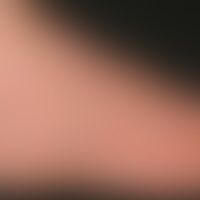
Tinea pedis moccasin type B35.30
tinea pedis "moccasin type": little inflammatory mycosis of the foot. arrows indicate the proximal extensions of the mycosis on the back of the foot. the encircled scaling is also induced by mycosis.
